Physical Address
304 North Cardinal St.
Dorchester Center, MA 02124
Physical Address
304 North Cardinal St.
Dorchester Center, MA 02124
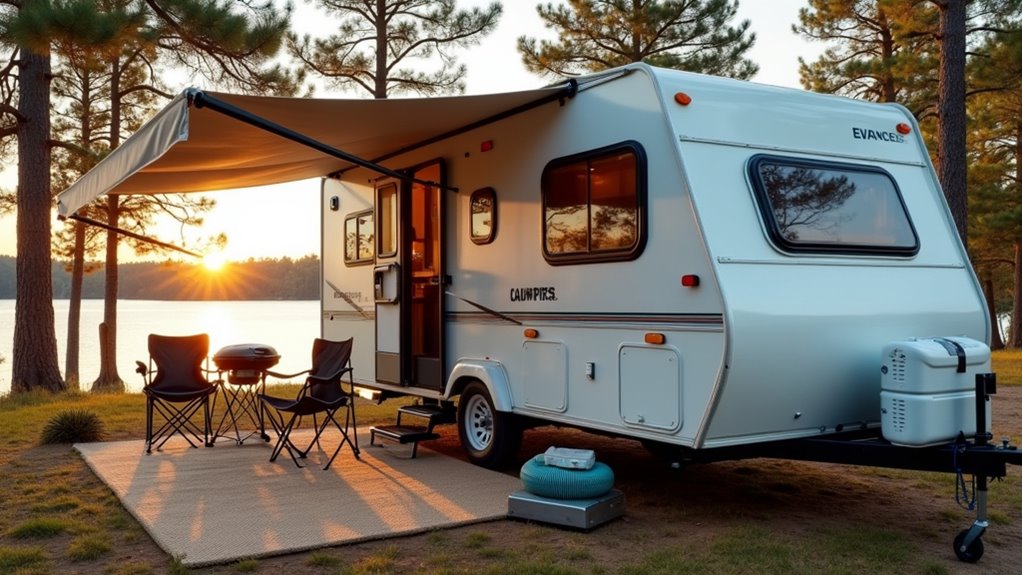
Discover essential RV camping secrets that seasoned travelers swear by, from choosing the perfect spot to avoiding common rookie mistakes.
You’ve dreamed about hitting the open road in an RV, and now it’s time to turn that dream into reality. Whether you’re a first-timer or returning enthusiast, successful RV camping requires more than just picking a destination and driving off into the sunset. From choosing the right vehicle to mastering campsite setup, you’ll need to navigate various challenges to create those perfect outdoor memories. Let’s explore the essential tips that’ll transform your RV adventure from potentially stressful to absolutely memorable.
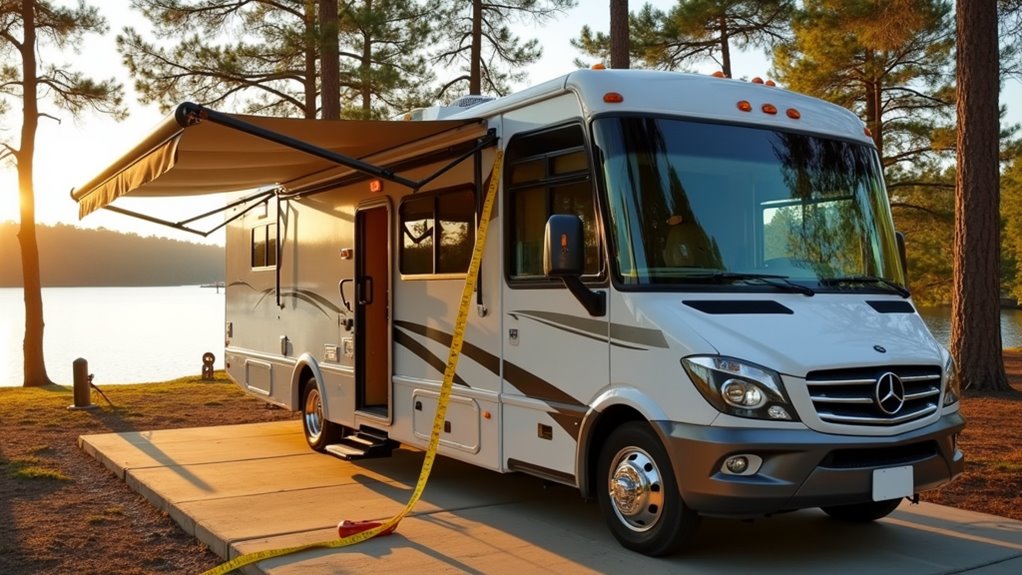
When starting on an RV camping adventure, selecting the right recreational vehicle can make or break your experience.
You’ll need to take into account your family size, trip duration, and destination terrain to find your perfect match.
If you’re traveling with a larger family, you’ll want to focus on travel trailers or Class C motorhomes that offer more sleeping capacity and living space. Park Model RVs are another excellent option for large families, offering up to 10 sleepers.
For weekend getaways, a pop-up camper or teardrop trailer might suit your needs perfectly. Essential tips for a great RV camping experience can help you prepare for your trip.
If you’re planning remote adventures, think about a truck camper or compact Class B motorhome for better maneuverability.
Your budget will greatly influence your choice between towable and driveable options.
While towables start at $10,000, they’ll require a capable towing vehicle.
Driveables offer more convenience but come with higher price tags starting at $65,000.
Before hitting the open road, a thorough pre-trip inspection of your RV can prevent unexpected breakdowns and guarantee a safe journey.
Start with the engine compartment by checking all fluid levels, inspecting belts and hoses for wear, and ensuring your battery’s in good condition. Check all components carefully for any signs of leaks. Don’t forget diesel-specific checks if applicable.
Never overlook engine basics – fluids, belts, hoses, and battery condition are your first defense against roadside troubles.
Your tires need special attention – verify proper pressure, adequate tread depth, and examine sidewalls for damage. Rotating your tires at regular intervals can also extend their lifespan.
Move through the exterior, securing awnings and slide-outs, checking lights, and managing your propane and water tanks.
Inside, you’ll want to turn off all systems and secure loose items.
Finally, don’t skip vital safety checks. Test your brakes, verify your hitch connection, and lower antennas.
Remember to lock all compartments and double-check that you’ve got all essential keys before departure.
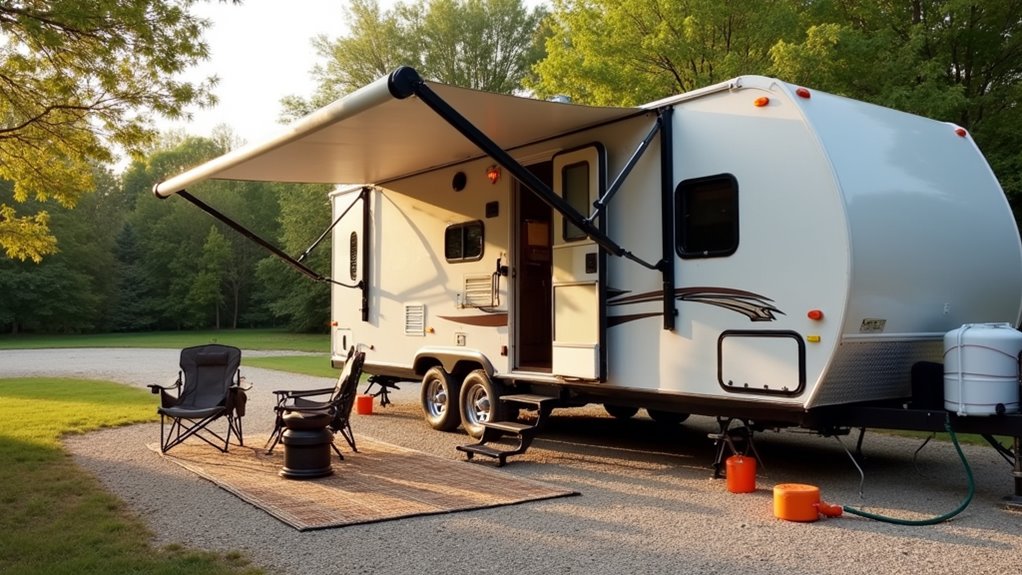
Once you’ve found the perfect spot at your campground, transforming it into a comfortable home base requires methodical setup and attention to detail.
Start by connecting your RV to essential utilities – shore power, water, and sewer lines. Be sure to walk the site first to identify any potential hazards like broken glass or low-hanging branches. Next, stabilize your rig and extend the slide-outs if you have them.
Turn your attention to creating a welcoming outdoor space by rolling out the awning and setting up your patio area with furniture and lighting. RV camping outshines tent adventures by providing more amenities and a higher level of comfort.
Don’t forget to place a secured mat to keep dirt out of your RV.
Inside, activate your systems by switching on the refrigerator, water heater, and propane. Set up your living spaces with bedding, kitchen essentials, and bathroom supplies.
Finally, verify safety by checking for hazards, securing entry steps, and keeping emergency equipment accessible.
Mastering your RV’s electrical and water systems can seem intimidating at first, but understanding these interconnected networks is essential for a comfortable camping experience.
Your RV runs on two electrical systems: a 12-volt DC system powered by deep-cycle batteries for basics like lights and water pumps, and a 120-volt AC system for larger appliances when you’re connected to shore power or using a generator.
Remember that high-draw appliances like microwaves, coffee makers, and air conditioners should not be run simultaneously to maintain system stability. A camping generator can provide the additional power needed for these high-draw appliances.
To manage your power effectively, you’ll need to monitor your battery levels and plan your energy usage. When you’re dry camping, conserve power by using your water pump sparingly.
For longer stays off-grid, consider adding solar panels to keep your batteries charged. When you’re at a campground, always use a surge protector when connecting to shore power, and be mindful of the amperage limits to avoid overloading your system.
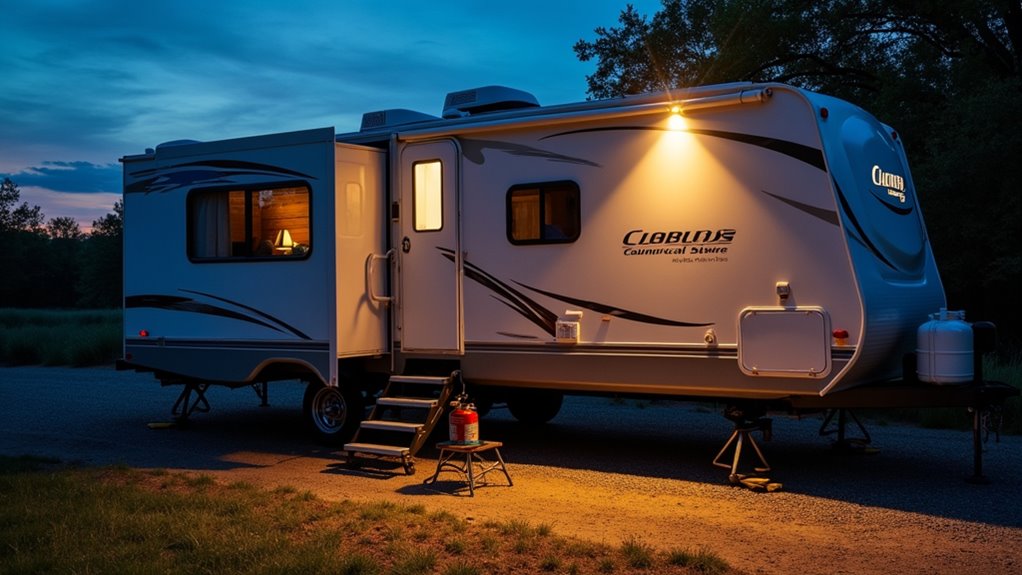
Whether you’re a seasoned RV enthusiast or new to the lifestyle, safety protocols form the foundation of every successful camping adventure.
Start by mastering your pre-departure checklist: check tire pressure, secure loose items, and verify all appliances are off. Ensure your weight is balanced throughout the RV for optimal towing stability. You’ll also need to guarantee your safety equipment is functioning properly, including smoke alarms, carbon monoxide detectors, and fire extinguishers. RV rentals can provide a convenient and cost-effective way to explore the great outdoors.
During travel, keep your safety chains properly connected and maintain an emergency kit onboard.
When setting up camp, choose a level site that accommodates your RV’s dimensions, and always chock your wheels.
Don’t forget to conduct regular maintenance checks of critical systems like propane tanks and generators.
These safety measures aren’t just guidelines – they’re essential practices that’ll protect you and your fellow campers while maximizing your RV experience.
After ensuring your RV’s safety protocols are in check, you’ll need a smart packing strategy to make the most of your limited space.
Start by organizing your essentials into distinct categories: RV technical gear, kitchen supplies, sleeping essentials, personal items, and outdoor equipment.
Pack your RV technical items first, including the surge protector, water hose, and sewer kit – they’re non-negotiable for a functioning mobile home. Renting camping gear can also be a cost-effective option to supplement your outdoor equipment.
Next, focus on multi-purpose kitchen tools like a quality cutting board and versatile skillets.
Don’t skimp on bedding comfort; bring proper sheets and warm blankets.
Keep personal hygiene items compact but complete, and store medications in an easily accessible spot.
For outdoor enjoyment, prioritize space-saving items like collapsible chairs and a portable fire pit that’ll enhance your camping experience. Don’t forget to pack portable games for entertainment during downtime or rainy days.
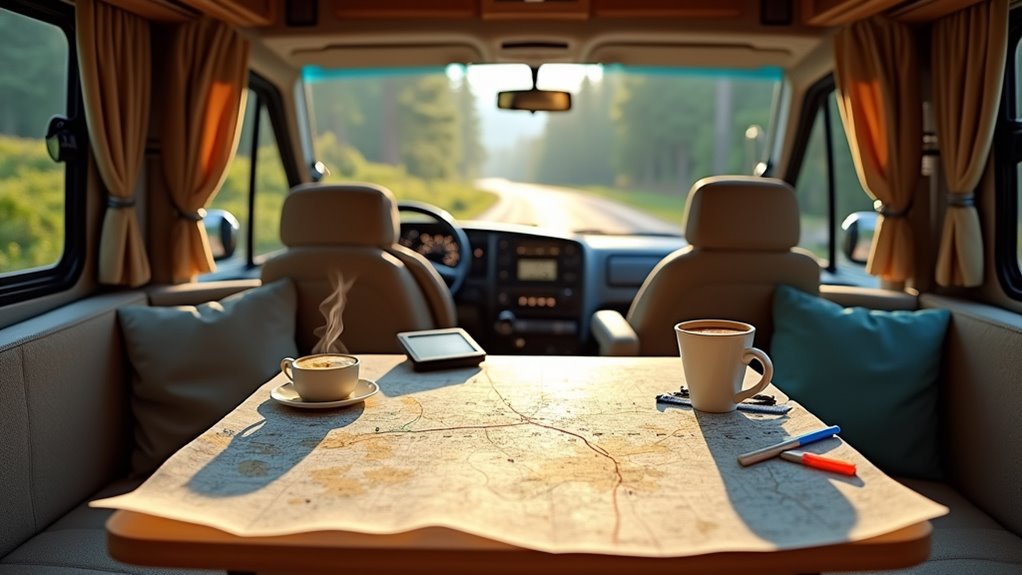
Smart route planning can make or break your RV adventure, and it’s about more than just getting from point A to point B. Use RV-specific mapping tools like RV LIFE Trip Wizard to identify safe routes that avoid low bridges, steep grades, and narrow roads.
Planning an RV route requires specialized tools and careful consideration to ensure safe passage and avoid potential hazards along the way.
You should aim to download offline maps for areas with spotty cell service.
Plan your stops strategically by booking campgrounds in advance, especially during peak seasons. Consider using these locations as hubs for exploring nearby attractions within a 50-100 mile radius. Being familiar with your RV specifications will help ensure you book sites that can accommodate your vehicle’s size and hookup needs.
RV adventures provide a great way for families to explore during the summer months. Don’t forget to schedule rest breaks every 2-3 hours and fuel stops every 200-250 miles at RV-friendly stations. Keep a list of backup campgrounds and alternative routes handy for unexpected situations like road closures or weather events.
Successfully steering your route leads to the next challenge: keeping your RV comfortable in any weather. You’ll need to adapt your strategies as conditions change.
In hot weather, park with your nose away from the sun and use reflective window covers to keep the interior cool. Don’t forget to create cross-ventilation when possible. Consulting weather forecast websites before each day’s activities helps you plan appropriate cooling measures.
For cold weather, insulate your windows with plastic and thermal drapes, and seal any gaps with foam. Add throw rugs to protect against heat loss through the floor. Keep humidity between 30-40% using a dehumidifier and proper ventilation to prevent mold. Proper winter camping gear is essential for staying cozy.
When severe weather approaches, retract awnings and slide-outs, turn your RV into the wind, and secure loose items. Always monitor weather forecasts and be ready to relocate to safer ground if conditions worsen.
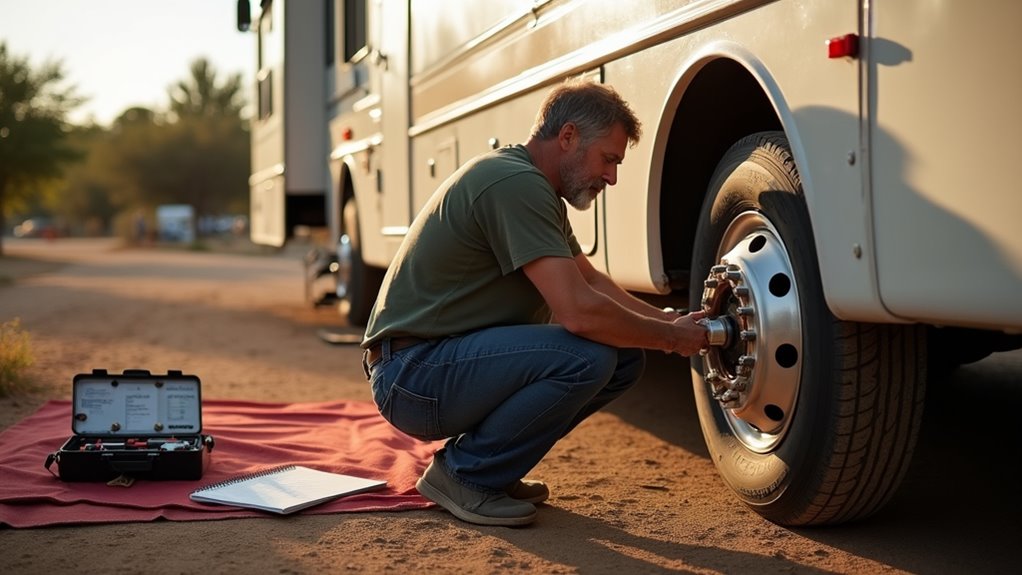
Maintaining your RV’s essential systems while traveling can prevent costly breakdowns and guarantee a smooth journey. You should aim to establish a routine of checking your tire pressure, brake system, and all fluid levels before hitting the road.
Don’t forget to test your smoke, CO, and propane detectors regularly.
Safety first: Regular testing of smoke, CO, and propane detectors is crucial for protecting yourself and your loved ones during RV adventures.
Pay special attention to your propane system by inspecting tanks for leaks and ensuring all fittings are secure. Running your RV generator monthly will help maintain its optimal performance. Your roof needs regular checks too – look for cracks in seals and seams that could let water seep in.
Texas RV parks offer a variety of amenities and scenic settings to make your camping experience more enjoyable.
Keep your exterior clean and waxed to protect against UV damage.
Monitor your battery voltage and electrical connections, and don’t skip regular oil changes.
Remember to inspect your windshield wipers and test all exterior lights to keep yourself safe during travel.
As the RV community grows increasingly conscious of environmental impact, adopting eco-friendly camping practices has become essential for preserving our natural spaces.
You’ll find that small changes make a significant difference: install solar panels to reduce fossil fuel dependency, switch to LED lighting, and maintain your RV for peak fuel efficiency.
Consider upgrading to low-flow faucets and water-efficient appliances to minimize water consumption. Implementing rainwater harvesting systems can significantly reduce your freshwater usage while camping. Dry RV camping can also help conserve water by reducing the need for water hookups.
When it comes to waste management, embrace the “pack it in, pack it out” philosophy.
Set up a recycling system in your RV, use reusable containers instead of disposables, and consider composting your food waste.
Choose campgrounds that prioritize sustainability, and stick to established sites to protect natural habitats.
Support local economies by purchasing organic products from nearby vendors, reducing your carbon footprint while enriching the community.
You’ve mastered the essentials of RV camping, and now you’re ready to hit the road. Isn’t it amazing how you’ll often meet fellow campers who become lifelong friends around the campfire? Whether you’re parked at a scenic mountain site or beachside paradise, you’ll find these tips transform your adventures from good to extraordinary. Remember, the most memorable trips aren’t just about the destination – they’re about the journey and the unexpected joys you’ll discover along the way.